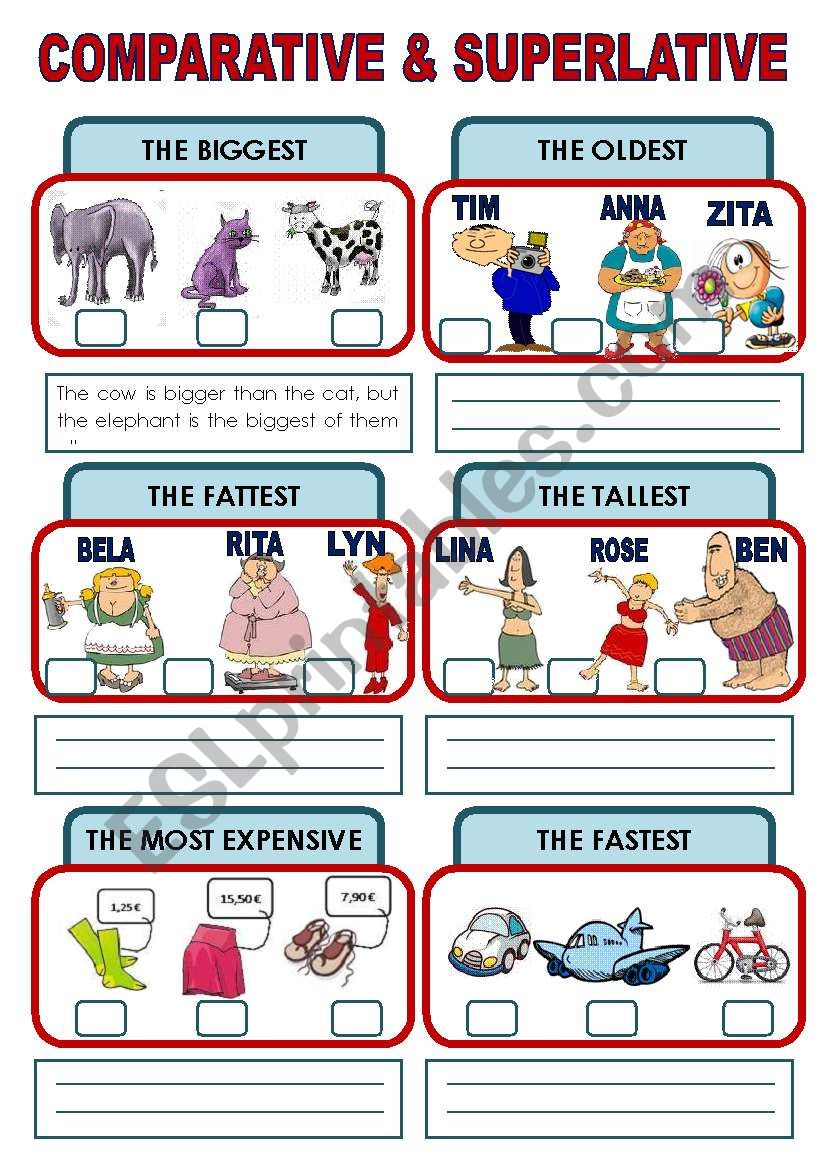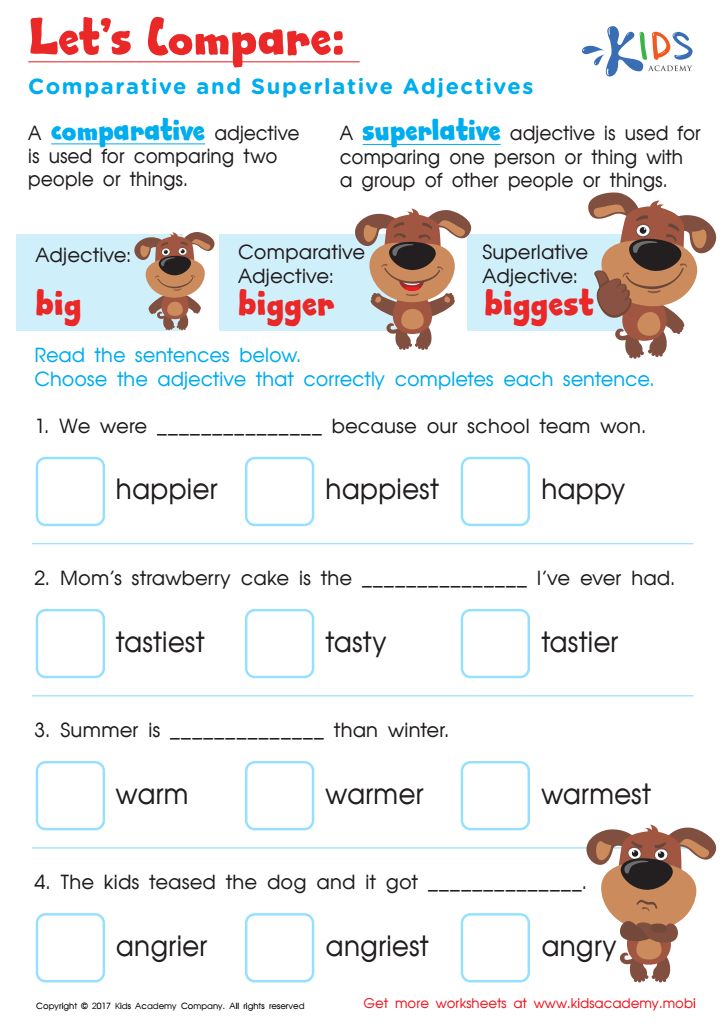
Mastering Degrees of Comparison: The Indispensable Role of Comparative and Superlative Grammar Worksheets
In the intricate tapestry of the English language, few grammatical concepts are as fundamental yet frequently challenging as comparatives and superlatives. These degrees of comparison allow us to express differences and extremes, shaping our ability to describe the world with nuance and precision. From comparing the speed of two cars to identifying the tallest building in a city, understanding and correctly applying these forms is crucial for both native speakers and English language learners alike. While theoretical knowledge is a good starting point, true mastery is forged through consistent practice, making comparative and superlative grammar worksheets an utterly indispensable tool in any language learning journey.
This article will delve into the profound importance of comparatives and superlatives, explore the pedagogical value of worksheets, discuss various types of effective exercises, and ultimately underscore why comparative and superlative grammar worksheets are not just supplementary materials, but cornerstones of effective grammar acquisition.
The Essence of Comparison: Understanding Comparatives and Superlatives

Before exploring the worksheets themselves, it’s vital to briefly revisit the core concepts:

- Comparatives: Used to compare two things (people, objects, ideas, etc.). They typically involve adding "-er" to short adjectives (e.g., taller, faster) or using "more" before longer adjectives (e.g., more beautiful, more intelligent). The structure often includes "than" (e.g., "John is taller than Mary").
- Superlatives: Used to compare three or more things and identify the one that possesses the highest or lowest degree of a particular quality. They usually involve adding "-est" to short adjectives (e.g., tallest, fastest) or using "most" before longer adjectives (e.g., most beautiful, most intelligent). The structure almost always includes "the" (e.g., "Sarah is the smartest student in the class").
- Irregular Forms: A significant hurdle for learners are the irregular adjectives and adverbs that don’t follow the standard rules (e.g., good/better/best, bad/worse/worst, far/farther/farthest or further/furthest). These require rote memorization and dedicated practice.


The complexities arise from factors such as adjective length, spelling rules for adding "-er/-est" (e.g., doubling consonants, changing ‘y’ to ‘i’), and the correct usage of "more/most" versus "-er/-est." This is precisely where well-designed comparative and superlative grammar worksheets step in to demystify these rules and embed them through repetitive, contextualized practice.
Why Worksheets? The Unparalleled Value of Active Practice
In an age of interactive apps and digital learning platforms, the humble worksheet might seem old-fashioned. However, its enduring effectiveness lies in its ability to facilitate active, focused, and repeatable practice. Unlike passive learning methods like reading grammar rules, worksheets demand that learners actively apply their knowledge, making decisions, filling in blanks, and correcting errors.

Here’s why worksheets are so valuable:
- Reinforcement and Retention: Simply hearing or reading a rule once is rarely enough for long-term retention. Worksheets provide the necessary repetition to cement grammatical patterns in a learner’s memory. Each correct answer reinforces the rule, while mistakes offer immediate opportunities for correction and learning.
- Application in Context: Grammar rules can feel abstract in isolation. Worksheets present these rules within sentences and short paragraphs, showing how they function in real-world contexts. This contextualization helps learners understand meaning and usage beyond mere memorization.
- Identification of Weaknesses: As learners work through exercises, they inevitably encounter points of difficulty. Worksheets act as diagnostic tools, highlighting specific areas where a learner struggles (e.g., irregular forms, applying the correct "more/most" rule, or spelling changes). This allows for targeted review and practice.
- Confidence Building: Successfully completing exercises, especially those with increasing difficulty, builds a learner’s confidence. This sense of accomplishment is a powerful motivator to continue learning and tackling more complex grammatical structures.
- Self-Paced Learning: Worksheets allow learners to progress at their own speed. They can take their time, review rules as needed, and re-attempt exercises until they feel comfortable, making them ideal for both classroom use and independent study.



Diverse Types of Effective Comparative and Superlative Grammar Worksheets
Effective worksheets are not monotonous; they offer a variety of exercise types to engage different learning styles and address various aspects of comparative and superlative usage.
-
Fill-in-the-Blanks: This is perhaps the most common type. Learners are given sentences with a blank space and a base adjective/adverb in parentheses, requiring them to supply the correct comparative or superlative form.
- Example: "My new phone is (expensive) __ than my old one." (Answer: more expensive)
- Example: "She is (tall) __ person in her family." (Answer: the tallest)
-
Sentence Completion/Creation: Learners are provided with a prompt or a picture and asked to create a complete sentence using comparative or superlative forms.
- Example: "Compare a cat and a dog (fast): A dog is usually __ a cat." (Answer: faster than)
- Example: "Look at the three mountains. Describe the one that is (high): Mount Everest is __ mountain in the world." (Answer: the highest)
-
Error Correction: This type presents sentences containing errors in comparative or superlative usage, and learners must identify and correct them. This develops critical thinking and reinforces correct application.
- Example: "My brother is more older than me." (Correction: My brother is older than me.)
- Example: "This is the most good book I’ve ever read." (Correction: This is the best book I’ve ever read.)
-
Transformation Exercises: Learners are given a sentence and asked to rewrite it using a different comparative/superlative structure while retaining the original meaning.
- Example: "John is taller than Mark." (Rewrite using "not as…as": Mark is not as tall as John.)
- Example: "No one in the class is smarter than Emily." (Rewrite using superlative: Emily is the smartest person in the class.)
-
Picture-Based Activities: Visual cues are incredibly helpful, especially for young learners or visual learners. Worksheets might show a series of objects (e.g., three different sized trees, two different speed cars) and ask learners to describe them using comparatives and superlatives.
-
Comparison Charts/Tables: Learners might be given data in a table (e.g., heights of family members, prices of different cars, performance of different athletes) and asked to write sentences comparing and contrasting the items using appropriate forms.
-
Role-Playing/Dialogue Prompts: While not purely "worksheet" in the traditional sense, some worksheets can include prompts for short dialogues where learners must use comparatives and superlatives to discuss preferences, comparisons, or opinions.
-
Writing Prompts: More advanced worksheets might ask learners to write a short paragraph comparing two cities, three different types of food, or ranking items based on certain criteria, requiring them to integrate multiple comparative and superlative forms naturally.
Designing and Selecting Effective Comparative and Superlative Grammar Worksheets
For educators creating their own materials, or learners choosing resources, quality matters. Effective comparative and superlative grammar worksheets share several key characteristics:
- Clear Instructions: Ambiguity hinders learning. Instructions should be concise and easy to understand.
- Gradual Difficulty: Worksheets should ideally progress from simpler exercises (e.g., regular adjectives) to more complex ones (e.g., irregular forms, multiple comparisons in one sentence).
- Variety of Exercise Types: As discussed, different exercise formats keep learners engaged and address various learning objectives.
- Contextual Relevance: Sentences and scenarios should be relatable and meaningful to the learner. Using examples from everyday life or topics of interest makes the practice more engaging.
- Adequate Repetition: While variety is good, there needs to be enough repetition of each rule to ensure it sticks.
- Answer Keys: For independent study, self-correction is crucial. A clear answer key allows learners to check their work immediately and understand their mistakes.
- Visual Appeal: For younger learners especially, clear layout, appropriate font sizes, and relevant images can significantly enhance engagement.
The Benefits Across Learner Levels
Comparative and superlative grammar worksheets are universally beneficial, adapting to different stages of language acquisition:
- Beginner ESL/EFL Learners: They provide foundational practice, helping learners distinguish between adjectives and adverbs and apply basic "-er/-est" and "more/most" rules.
- Intermediate Learners: Worksheets can focus on irregular forms, subtle nuances of usage, and more complex sentence structures involving comparisons. Error correction exercises are particularly valuable here.
- Advanced Learners: For those nearing fluency, worksheets can challenge them with idiomatic expressions involving comparisons, nuanced distinctions, and the integration of comparative/superlative forms into extended writing tasks.
- Young Learners: Picture-based, game-like worksheets make learning fun and accessible, focusing on visual recognition and simple comparisons.
- Adult Learners: Structured and clear worksheets provide the systematic practice many adult learners prefer, allowing them to methodically master the rules.
- Self-Study: Worksheets with clear instructions and answer keys are ideal for independent learners who want to supplement their classroom learning or study at their own pace.
Integrating Worksheets into a Holistic Learning Plan
While invaluable, comparative and superlative grammar worksheets should be part of a broader language learning strategy. They are most effective when integrated thoughtfully:
- Pre-Assessment: Use a simple worksheet to gauge learners’ existing knowledge before introducing the topic.
- Guided Practice: After explaining the rules, work through the first few exercises together as a class or with a tutor, providing immediate feedback.
- Independent Practice: Assign worksheets for homework or independent classwork, allowing learners to apply what they’ve learned on their own.
- Review and Reinforcement: Revisit comparative and superlative forms periodically with new worksheets to ensure long-term retention.
- Beyond the Worksheet: Encourage learners to apply comparatives and superlatives in real-world contexts – describing their friends, comparing products, or discussing news articles. Role-playing, debates, and presentations are excellent ways to transition from worksheet practice to communicative use.
Conclusion
The ability to compare and contrast is a cornerstone of effective communication, and mastering comparative and superlative forms is a non-negotiable step on the path to English fluency. While grammar instruction, listening, and speaking practice all play their parts, the consistent, structured application offered by comparative and superlative grammar worksheets is truly irreplaceable. They provide the necessary repetition, contextualization, and self-correction opportunities that transform abstract rules into ingrained linguistic habits.
Whether you are an educator striving to provide your students with robust practice, or a diligent learner committed to honing your grammatical accuracy, embracing high-quality comparative and superlative grammar worksheets will undoubtedly accelerate your progress and solidify your command over these essential degrees of comparison. They are not merely papers filled with exercises; they are vital tools that empower learners to describe the world with precision, express nuanced opinions, and communicate with greater confidence and clarity.
